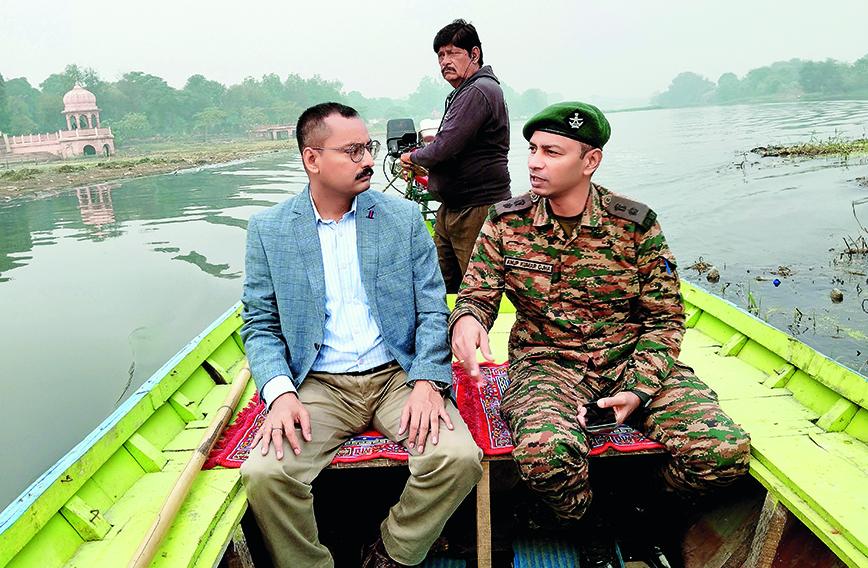
VENKATESH DUTTA
THE Ganga Task Force (GTF) was stationed along the banks of the Ganga with the objective of preventing pollution from both industries and citizens. The GTF is a specialized unit of the Territorial Army established under the public participation component of the Namami Gange programme. The GTF conducts routine patrols of the ghats to monitor activities such as the disposal of idols, flowers and other materials into the Ganga. Boat patrols are conducted to observe and safeguard biodiversity, ensuring that fishing activities in the Ganga adhere to approved practices. This proactive approach helps protect the flora, fauna, and aquatic species in the Ganga.
The GTF has established an impressive nursery in the cantonment of Prayagraj, boasting thousands of saplings. The task force is actively engaged in planting trees along the banks of the Ganga. This afforestation initiative is one of the primary tasks undertaken by the GTF to contribute to the conservation and revitalization of the river.
Recently, the GTF carried out plantation work to reduce soil erosion in Kanpur. Vetiver (khus) saplings were planted on the banks of the Ganga to prevent soil erosion along with local villagers and schoolchildren.
The Ministry of Defence approved the establishment of four battalions of the Composite Eco Task Force (CETF) named as the Ganga Task Force exclusively for restoration of the Ganga. The first company of the Ganga Task Force Battalion was deployed at Garhmukteshwar in January 2016. Three such companies were deployed at Kanpur, Varanasi and Prayagraj.
The establishment of the first Ecological Task Force (ETF), also known as the Ecological Battalion, took place in 1982. Alarmed by the widespread ecological degradation in the Shivaliks due to mining, Dr Norman Borlaug, the American agronomist who contributed immensely towards the Green Revolution, recommended to the then prime minister, Indira Gandhi, that the Indian Army be engaged to restore the ecological balance on a war footing. The initiative also stemmed from the insight provided to Mrs Gandhi that unemployment among retired soldiers and deforestation and soil erosion could be tackled simultaneously. The 127 Infantry Battalion was assigned the task of working on the Shivalik hills around Mussoorie, an area severely impacted by rampant mining, causing damage to the local ecosystem. The results were impressive, leading to a thick forest cover in the Shahjahanpur Range where they operated.
Recently, in October 2023, the 51st Executive Committee of the Namami Gange project approved the deployment of one company of the Territorial Army of the GTF for the rejuvenation of the Gomti, a tributary of the Ganga. The Gomti is the first tributary of the Ganga to have its own Ecological Task Force. The task force is entrusted with protecting the river’s biodiversity and patrolling riverbanks by boat and on foot, monitoring various public ghats, overseeing river pollution, and providing assistance during floods or natural calamities in the region. The task force will also conduct various public awareness campaigns for engaging citizens in river cleaning.
Battalions of the ETF have achieved notable success in the ecological restoration of severely degraded sites, such as the limestone mining areas in the Mussoorie hills and the Bhatti mines in South Delhi. In 2001, the Government of Delhi approved a project for the rehabilitation of 2,100 acres of the abandoned Bhatti mines in the southern ridge area, which includes the Bhatti Wildlife Sanctuary. This project was executed through the ETF of the Territorial Army. The ETF effectively safeguarded the forest land from encroachment and illegal mining in the area temporarily assigned to it. Apart from the ETF, separate river police units are being created to address the challenges associated with poor information networks and policing constraints in riverine areas.
River Police Stations were established in London along the Thames more than 200 years ago. The Thames River Police, established in 1798, holds the distinction of being recognized by UNESCO as the longest continuously serving police force in the world. The river police plays a vital role in checking crime and facilitating swift response at the site of crime near rivers. Improved infrastructure, communication equipment, and dedicated deployment in these areas contribute to effective law enforcement and crime prevention.
In Bangladesh, the river police was established in 2013, as a specialized unit within the police force. It is tasked with the responsibility of policing the internal waterways of Bangladesh. Its duties extend to overseeing and regulating activities such as fishing and ensuring safety and security in riverine areas.
In India, the Assam government established a ‘River Police Organization’ in 1979. This organization led to the formation of a separate river police district along the mighty Brahmaputra, encompassing Goalpara, Kamrup and Darrang districts. The riverine area covers 110 km along the India-Bangladesh border. It comprises four river police stations and six outposts, emphasizing the strategic need for specialized law enforcement along the river to ensure security and safety in the region. Given the challenging terrain of riverine areas, meticulous patrolling is essential, including accessibility of mechanized motorboats, wireless equipment, and other modern gadgets.
Due to illegal sand mining, there are many hotspots along the Ganga in UP and Bihar with enhanced security challenges. Consequently, the demand for river police stations was raised also to address and prevent crime in the riverine belts adjacent to rivers. A proposal to establish river police in Bhagalpur in Bihar was made in 2009 to check crime and introduce patrolling in difficult riverine areas. In Kashmir, river policing has a longstanding legacy. There was a River Police Chowki at Basant Bagh, Srinagar, that was later closed. Currently, a small team of rescue and recovery river police is deployed along the Dal Lake and the Jhelum river to address accidental drowning incidents and emergencies.
In the Gomti river basin, the task force is well equipped to execute river restoration and ecology-related projects. It needs all the support it can get.
Venkatesh Dutta is a Gomti River Waterkeeper and a professor of environmental sciences at Ambedkar University, Lucknow
Comments
-

Tara - Jan. 8, 2024, 2:22 p.m.
Reading this piece has opened my eyes towards the need for a 'force for the river'. This really is remarkable work and should be spoken about more widely. Thank you for this insightful piece.
-

Col Jasjit Singh Gill - Dec. 24, 2023, 6:52 p.m.
This is comprehensive article which mentions the river police stations for keeping rivers free from pollution . After a longtime I have read someone mentioning Vetiver “ KHUSS” grass which has not been used for green edging of river or nalla banks India because it’s most under estimated and under used plant for soil conservation and soil erosion in India of which this plant VETIVER “KHUSS” is a native of Tamil Nadu, India .Thanks for highlighting the requirement of ecological battalions at national level which the states can raise for use to conserve, clean their rivers and save their water bodies from pollution sources by protecting these life giving waters.
-

Col CM Lakhanpal - Dec. 24, 2023, 5:41 a.m.
ETF Bn are doing cxcellent job everywhere including Rajasthan. Punjab needs four such Battalions (Bn). One each for rivers Satluj, Beas, Ravi and Ghaggar. Must be done on Priority to save these rivers and the Ecology.
-

Dr. Narasimha Reddy Donthi - Dec. 23, 2023, 7:11 p.m.
Most of the pollution in Ganga and other rivers is due to administrative inaction, and action, in letting effluents and sewerage into the rivers. the Task Force does not seem to have any role in preventing such major incursion into river ecology.




